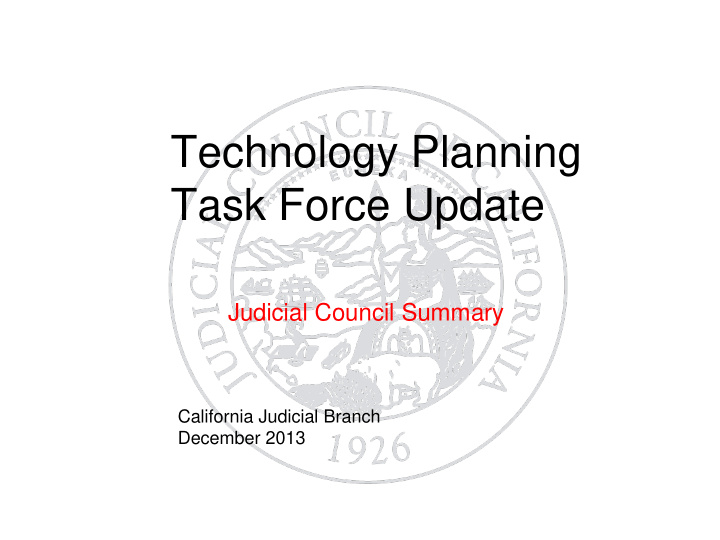



Technology Planning Task Force Update Judicial Council Summary California Judicial Branch December 2013
Background Authorized by the Chief Justice in February 2013 to address judicial branch technology governance and strategy. Task force will work in collaboration with the courts to: Propose a strategic plan, tactical plan, and funding model for managing technology. Identify and promote opportunities for court collaboration and consortia. Page 2
Roles and Responsibilities Proposes structure, models, and areas of focus Technology Does not implement, execute, or select Planning solutions Task Force Will terminate in 2014 Oversees, approves, set priorities for Technology branchwide initiatives and initiatives that use Committee branch funds Courts, Implement, execute, and select solutions AOC Page 3
Milestones Action Month Conducted 3 regional meetings to present detailed strategic planning proposals, get November feedback and input. Provide process update to Judicial Council. December Present updated proposals to Judicial Council. January Submit proposal for public comment. March Submit final proposal to Judicial Council for June approval. Page 4
Feedback from other Government Branches October 2012 October 2013 Need to have a mature Overall favorable decision making process. response to the proposals and work in Need a strategic plan process. with technology governance model and a technology roadmap. Page 5
Summary of Proposed Recommendations Page 6
Proposed Governance Recommendations Judicial Council 1. Work as an IT community. Technology Committee IT Advisory Committee 2. Technology Committee provides Supreme Courts of branch wide oversight, Court Appeal prioritization and coordination of IT Trial initiatives & funding strategies. AOC Courts 3. CTAC focuses on rules and facilitating court technology Statewide Programs and Solutions projects funded in whole or in part Statewide Standards and Guidelines at the branch level. Consortium Programs and Solutions Defined, managed, and Local Extensions maintaine Establishe d at the d at the branch Multi- 4. Categorize technology initiatives branch level. Local Locally court level. Mandator collaborat managed and Programs y ion. developed E.g. Digital participat Optional based on document ion. Locally statewide participati from branchwide programs to local standards. managed and solutions. on. E.g. developed. Judicial E.g. DMS E.g. Electronic Financial E.g. Courtroom RFP, CMS Legal File. System. audio/visual. RFP. programs Page 7
Proposed Strategic Plan Recommendations • Improve access, administer timely, • Encourage technology innovation, efficient justice, gain case processing 1. Four strategic goals to align collaborative court initiatives, and efficiencies and improve public safety professional development, to maximize through electronic services for public the use of personnel resources, interaction and collaboration with technology assets, and leveraged justice partners. E.g. CMS, DMS, e- procurement. E.g. technical filing, online services. communities, contracts. Promote Optimize technology initiatives around the Digital Branch Court Resources the “Digital Court”. Promote Optimize Rule and Infrastruc- Legislative ture 2. Launch tactical initiatives to Changes • Leverage and support a reliable • Drive modernization of secure technology infrastructure. statutes, rules and Ensure continual investment in procedures to facilitate use existing infrastructure and exploration of technology in court of consolidated and shared computing operations and delivery of implement our goals. where appropriate. E.g. network, court services. E.g. e-filing, disaster recovery. privacy, digital signatures. 3. Utilize an analytical transparent process and tool Project Evaluation Criteria Score Range Alignment with Branch Strategic Goals (Access) 0-6 goals Alignment with Branch Technology Priorities None - High Business Alignment External partner Alignment None - Yes for evaluating technology Business Alignment Sub-Total Scope of impact Single Court - Branchwide Financial ROI No ROI – 2 years Business Impact proposals, risk, and return on Likelihood of benefit realization No probability - High Business Impact Sub-Total Urgency for change – operations Not urgent - Urgent Urgency for change - legal/regulatory/compliance Business Risk Not urgent - Urgent investment (ROI). Mitigation Organizational readiness Significant Concerns - Ready Business Risk Mitigation Sub-Total Level of alignment with branchwide technology standards None - Aligned Technology Alignment Level of alignment with branchwide vendors None - Aligned / Fit Level of alignment with branch architecture None - Aligned Technology Alignment / Fit Sub-Total Existing infrastructure can support this project No. Separate project - Covered Identified tech staff can support this technology No - Covered Technology Risk Product / technology maturity End of Life / Immature - Mature Technology Sub-Total Page 8
Proposed Funding Model Recommendations 1. Create technology funding categories for branchwide New Branchwide Initiatives initiatives, on-going maintenance, and innovation. Intermittent Routine Innovation and Upgrade Upgrade Improvement 2. Delineate allocation and expenditure of these funds at Operations – Keep it Running the branch and local level. On-going Branchwide Standards and Protocols 3. Align funding sources with current and future spend. Page 9
Expected Outcomes • Clear robust structure, roadmap, and process for managing technology initiatives and investments. • Transparency of how funds are managed and allocated. • Increased credibility for managing public funds and resources. • Consistent availability of services across courts. • Better accountability for use of resources. Page 10
Recommend
More recommend